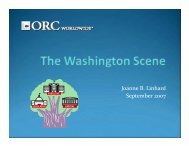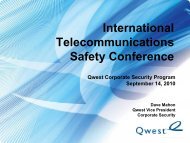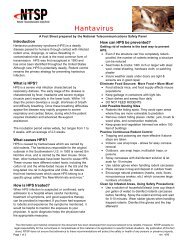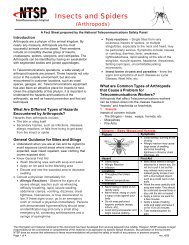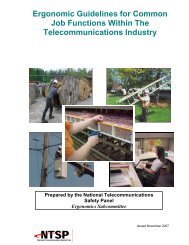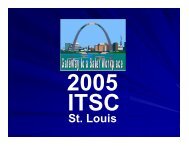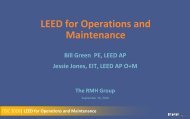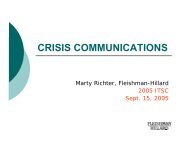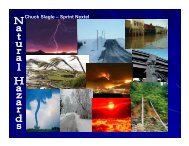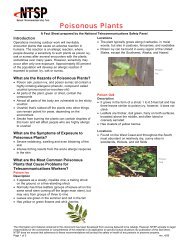LaPorte Risk Assessment PPT
LaPorte Risk Assessment PPT
LaPorte Risk Assessment PPT
Create successful ePaper yourself
Turn your PDF publications into a flip-book with our unique Google optimized e-Paper software.
<strong>Risk</strong> <strong>Assessment</strong> – A Useful Tool<br />
Jim La Porte, CSP, CHMM
Winners of the:<br />
JOB SAFETY AWARD
5º PLACE
4º PLACE
3º PLACE
2º PLACE
AND THE<br />
WINNER IS...
<strong>Risk</strong> Chlorinated <strong>Assessment</strong> Truths:<br />
Solvents<br />
Asbestos<br />
Every action, task, job, process has a<br />
certain amount of risk.<br />
Decisions are made every day by<br />
individuals, governments,<br />
and corporations about risk.<br />
A risk or degree of risk to<br />
one person may be different<br />
to another.<br />
Perception of risk changes<br />
over time and with<br />
ones experiences! What is<br />
acceptable and what is not?
Health, Myths Regarding Safety &<br />
<strong>Risk</strong><br />
Environmental <strong>Assessment</strong>s<br />
(HSE)<br />
professionals are<br />
They are complex and take too much<br />
time to complete.<br />
always doing some sort<br />
They are based on complex<br />
techniques.<br />
of risk assessment<br />
whether it be inspecting<br />
They do not go beyond the<br />
regulations.<br />
a hazardous waste<br />
No risk is acceptable.<br />
storage area or<br />
Everyone perceives a risk the same<br />
way.<br />
observing the safe<br />
practices of an<br />
employee in the field.
Concerns about <strong>Risk</strong> <strong>Assessment</strong>s<br />
They are not communicated<br />
effectively (risk communication).<br />
They are not realistic in their scope<br />
and application.<br />
In many cases they don’t utilize the<br />
actual people doing, maintaining or<br />
carrying out the task.<br />
Once a risk assessment is completed<br />
is not periodically reviewed as<br />
conditions change or warrant.<br />
Supported by management?
Practical Applications - Safety<br />
Accident investigations<br />
Employee complaints<br />
Equipment, machinery<br />
or process assessments<br />
Emergency response activities<br />
Safety auditing<br />
Safety observations
Practical Applications - Environmental<br />
Ground water contamination<br />
Air emissions<br />
Water discharges<br />
Property/land<br />
assessments<br />
Waste treatment solutions<br />
Environmental impacts
How <strong>Risk</strong> Manifests Its Self In Practical<br />
Terms<br />
Regulations (RMP, PSM, etc..)<br />
Product Design (Air Bag, Chair, etc..)<br />
Management Processes (Accounting<br />
principles)<br />
New Innovations – Hands Free<br />
Phone<br />
Banned or Eliminated (organic<br />
solvents – Methylene Chloride)<br />
New Laws –<br />
We all<br />
know<br />
what<br />
happened<br />
in this<br />
case!<br />
Consensus Standards (AHRAE,<br />
ANSI, etc..)
How is risk defined?<br />
Does eating too<br />
many Big Mac's<br />
cause obesity?<br />
What is the risk if I<br />
eat a Big Mac a<br />
day? What is the<br />
risk to the customer<br />
and the company?
<strong>Risk</strong> and <strong>Risk</strong> Perception Could<br />
Changes<br />
Imagine as a<br />
Over Time -WHY<br />
safety<br />
Regulatory -<br />
Cultural -<br />
Political Pressure -<br />
Injury/Accident experience -<br />
Public perception –<br />
Legal action -<br />
Scientific information -<br />
Interest groups -<br />
Research –<br />
Catastrophic events<br />
professional if you<br />
were asked to do<br />
a risk assessment<br />
on bunge jumping.<br />
Would you deem<br />
the risk<br />
acceptable?<br />
you<br />
Could<br />
imagine<br />
you<br />
this<br />
imagine<br />
today?<br />
this<br />
today?
<strong>Risk</strong> is defined many<br />
different ways<br />
<strong>Risk</strong> descended into<br />
English from the Italian<br />
rischio. It refers to<br />
possible damage or<br />
negative consequences<br />
due to unpredictable<br />
circumstances.
<strong>Risk</strong>:<br />
The computation of risk. <strong>Risk</strong> is a threat<br />
that exploits some vulnerability that could<br />
cause harm to an asset. The risk algorithm<br />
computes the risk as a function of the<br />
assets, threats, and vulnerabilities. One<br />
instance of a risk within a system is<br />
represented by the formula (Asset * Threat<br />
* Vulnerability). Total risk for a network<br />
equates to the sum of all the risk<br />
instances.<br />
securityresponse.symantec.com/avcenter/r<br />
efa.html
<strong>Risk</strong>:<br />
A study to determine risks posed by the site<br />
if no cleanup action was taken and what<br />
cleanup levels need to be established to be<br />
protective of human health and the<br />
environment. There are two types of risk<br />
assessments. Human health risk assessment<br />
looks at the risks to humans from<br />
contamination at the site and an ecological<br />
risk assessment looks at the risks to<br />
ecosystems, such as plants, fish, and<br />
animals, from contamination at the site.<br />
www.state.ak.us/dec/dspar/csites/glossary.ht<br />
m
<strong>Risk</strong>:<br />
Qualitative and quantitative<br />
evaluation of the risk posed to<br />
human health and/or the<br />
environment by the actual or<br />
potential presence and/or use of<br />
specific pollutants<br />
www.deq.state.mt.us/pcd/awm/haz/<br />
RCRA/RCRA_Glossary.asp
<strong>Risk</strong> <strong>Assessment</strong> Objectives<br />
Remember that the goal of a risk<br />
assessment to ultimately to anticipate and<br />
reduce or eliminate the likelihood of<br />
injury, property loss or impact on the<br />
environment. My experience has been<br />
that the earlier in the process a risk<br />
assessment of any type is employed the<br />
better. The practical application ranges<br />
from a person first getting into a car and<br />
putting on a seatbelt to the clean up of a<br />
superfund site.
OSHA even refers to the theory of risk<br />
assessment in the Michigan<br />
Occupational Safety & Health Act by<br />
requiring that each employer “furnish<br />
to each employee employment and a<br />
place of employment that is free from<br />
recognized hazards that are causing<br />
or likely to cause<br />
death or serious<br />
physical harm to the<br />
employee”.
When looking at the practical side<br />
of risk assessment we are looking<br />
at information that will help us<br />
truly understand the risks<br />
themselves for a particular task,<br />
job, process, piece of equipment,<br />
emission source, hazardous waste<br />
clean up, emergency response,<br />
etc..… Therefore knowledge<br />
concerning the risks is critical.<br />
Where do we get this information?
Data Available<br />
Through Various<br />
Sources; OSHA, EPA,<br />
BLS, ASSE, ACHMM,<br />
Trade Associations,<br />
Company<br />
Information,<br />
Manufacturer, etc…
Lets Look At The Practical Side Of<br />
<strong>Risk</strong> <strong>Assessment</strong> By Looking At<br />
Two Models In Theory and In<br />
Practice:<br />
<br />
<br />
A risk assessment<br />
on an industrial robot.<br />
A risk assessment of<br />
a manufacturing<br />
facility for ISO 14001.
<strong>Risk</strong> <strong>Assessment</strong> Process<br />
<br />
<br />
<br />
<br />
Hazard identification and<br />
recognition.<br />
Evaluation of the risk (i.e.<br />
ranking the risks by frequency,<br />
severity and probability).<br />
Eliminating or minimizing the<br />
risk.<br />
<strong>Risk</strong> communication.
The process of completing a risk<br />
assessment on an industrial robot follows<br />
the ANSI standard R15.06. In a condensed<br />
version it entails:<br />
1.Gathering information about the robot<br />
itself such as operating and maintenance<br />
information.<br />
2. Assembling a group of affected employees<br />
to identify what types of tasks are<br />
performed on the robot during both routine<br />
and non routine operations and the<br />
frequency of the task.(identifcatiion of<br />
Tasks)
The process should include for a<br />
piece of machinery, equipment or<br />
process:<br />
Persons who operate, maintain or<br />
otherwise interact with the<br />
machinery, equipment or process<br />
Engineering or design personnel<br />
Machinery, equipment or process<br />
manufacturer's)
Each Task is assessed by:<br />
One must<br />
Severity<br />
– Serious Injury<br />
consider QC<br />
defined as more than a first aid<br />
and<br />
and slight injury defined as a first<br />
aid.<br />
Maint/Service<br />
Exposure<br />
– Frequent or<br />
infrequent.<br />
functions that<br />
might be<br />
involved even<br />
Avoidance – Not likely or likely<br />
if infrequent.
Based on this information the risk is<br />
categorized into a specific risk<br />
reduction category ranging from R1 to<br />
R4. . Based on this risk category the<br />
safeguard performance is selected.<br />
These range from “hazard“<br />
elimination<br />
or hazard substitution” ” to the minimum<br />
of “awareness means”. Based on these<br />
the control circuit control is selected.<br />
This ranges from control reliable (fail<br />
safe) to simple.
<strong>Risk</strong> <strong>Assessment</strong> – Machinery Summary<br />
In many cases the process takes<br />
Lets look at<br />
some time and can not be done in<br />
one sitting.<br />
another They should<br />
risk<br />
be well<br />
documented.<br />
assessment<br />
As the machine changes or gets<br />
modified so should the safety<br />
controls.<br />
process with an<br />
The findings need to implemented<br />
environmental<br />
before the start of operation.<br />
environmental<br />
The controls<br />
flavor!<br />
installed must be<br />
properly installed, tested and<br />
maintained.
The process of completing a risk<br />
assessment an a manufacturing<br />
facility to complete the aspects and<br />
impacts portion of ISO 14001<br />
certification is like the robot risk<br />
assessment. The aspects and impacts<br />
starts with a group attempting to<br />
identify the aspects in the facility<br />
such as a bulk storage tank and their<br />
impact on the environment such as<br />
air, land, water. The next step is to<br />
quantify the risk.
Category<br />
1<br />
2<br />
3<br />
4<br />
frequency categorization<br />
Description<br />
Not expected to occur during the facility lifetime (50 yrs)<br />
Expected to occur several times within the facility lifetime<br />
Expected to occur more than once in a year<br />
Expected to occur more than once in a month<br />
Category<br />
0<br />
1<br />
2<br />
3<br />
consequence categorization<br />
Public Consequences<br />
No injury or health effects<br />
Minor injury or health effects<br />
Moderate injury or health effects<br />
Death or severe health effects
Category<br />
0<br />
1<br />
2<br />
3<br />
Employee Safety Consequences<br />
No injury or occupational safety effect<br />
Minor injury or minor occupational illness<br />
Moderate injury or occupational illness<br />
Death or severe occupational illness<br />
Category<br />
0<br />
1<br />
2<br />
3<br />
Environmental Consequences negative impact on the<br />
environment<br />
no significant environmental impact<br />
$1000 -$10,000 natural resource replacement value<br />
$10000 -$100,000 natural resource replacement value<br />
greater than $100,000 natural resource replacement value
Categor<br />
y<br />
0<br />
1<br />
2<br />
3<br />
Environmental Consequences in terms of regulatory/legal<br />
impact (fines/fees/reporting/operating costs) *<br />
no regulatory/legal obligation<br />
low *<br />
medium**<br />
high***<br />
* low =<br />
Categor<br />
y<br />
** medium =<br />
0<br />
***high =<br />
1<br />
2<br />
3<br />
small area or few environmental media impacted - little regulatory/legal involvement<br />
expected<br />
Business Interruption Consequences in terms of impact on<br />
customer<br />
moderate area or several environmental media impacted - regulatory/legal involvement<br />
and oversight expected<br />
no impact<br />
large area or groundwater impacted OR off-site contamination - regulatory/legal<br />
enforcement expected<br />
Shut down with no impact to customer<br />
Shut down the Tier I customer<br />
Shut down the assembly plant
Area<br />
Autowax<br />
Process Chemical Storage<br />
On-Line<br />
On-Line<br />
Chemical Unloading<br />
Chemical Unloading<br />
Chemical Unloading<br />
On-Line<br />
Foamer<br />
Foamer<br />
Foamer<br />
Foamer<br />
Chemical Transfer<br />
Chemical Transfer<br />
Aspects<br />
Autowax<br />
Bulk Storage - Wax<br />
Foam pour<br />
Mold opening & demold<br />
Tanker (TDI)<br />
Tanker (TDI)<br />
Tanker (TDI)<br />
Mold opening & demold<br />
TDI Surge Skid<br />
Pour head<br />
Pour head<br />
Pour head<br />
TDI<br />
TDI
Impacts<br />
Publ<br />
ic<br />
Con<br />
seq<br />
uen<br />
ces<br />
Emp<br />
loye<br />
e<br />
Safe<br />
ty<br />
Con<br />
seq<br />
uen<br />
ces<br />
Envi<br />
ron<br />
men<br />
tal<br />
Con<br />
seq<br />
uen<br />
ces<br />
-<br />
Imp<br />
act<br />
on<br />
Envi<br />
ron<br />
men<br />
t<br />
Envi<br />
ron<br />
men<br />
tal<br />
Reg<br />
ulat<br />
ory/<br />
Leg<br />
al<br />
Con<br />
seq<br />
uen<br />
ces<br />
Busi<br />
nes<br />
s<br />
Inter<br />
rupti<br />
on<br />
Con<br />
seq<br />
uen<br />
ces<br />
Con<br />
seq<br />
uen<br />
ces<br />
Subtotal<br />
Freq<br />
uen<br />
cy<br />
Tota<br />
l<br />
wax air emission<br />
1<br />
1<br />
1<br />
3<br />
3<br />
9<br />
4<br />
36<br />
air emissions<br />
0<br />
1<br />
0<br />
2<br />
1<br />
4<br />
4<br />
16<br />
air emissions<br />
0<br />
1<br />
0<br />
2<br />
1<br />
4<br />
4<br />
16<br />
air emissions<br />
0<br />
1<br />
0<br />
2<br />
1<br />
4<br />
4<br />
16<br />
spills - air emissions (TDI)<br />
1<br />
2<br />
0<br />
2<br />
3<br />
8<br />
2<br />
16<br />
spills -soil/groundwater<br />
impact<br />
0<br />
2<br />
3<br />
3<br />
0<br />
8<br />
2<br />
16<br />
spills -storm water impact<br />
0<br />
2<br />
3<br />
3<br />
0<br />
8<br />
2<br />
16<br />
waste chemicals from mis
What Other Formal <strong>Risk</strong><br />
<strong>Assessment</strong> Protocols Exist<br />
What If<br />
Fault Tree Analysis<br />
HAZOP<br />
Checklist<br />
8D<br />
Six Sigma
<strong>Risk</strong> <strong>Assessment</strong> Information:<br />
Enables decision makers to<br />
easily understand and<br />
categorize the risk to<br />
determine the methods and<br />
costs to reduce or eliminate<br />
the risk's.
Ultimately, the decisions are left<br />
up to Management. How do they<br />
respond?<br />
Take no action<br />
Modify<br />
Redesign<br />
Substitute<br />
Eliminate
If you asked anyone in<br />
your company What is<br />
the biggest risk to your<br />
companies future?<br />
Quality, stopped<br />
production, scrap,<br />
etc…
<strong>Risk</strong> Communications<br />
Formal Education & Training<br />
Accident/Incident Alerts<br />
Meetings<br />
Manuals<br />
Warnings Signs<br />
Observations
What Is Wrong With These Pictures!<br />
Talk About <strong>Risk</strong> Prevention!<br />
Maybe Resulting In A Lower<br />
Back Injury!<br />
Maybe Resulting In A Broken Leg<br />
Or Head Injury!
Questions???<br />
and remember<br />
GO BUCKEYES!!!



